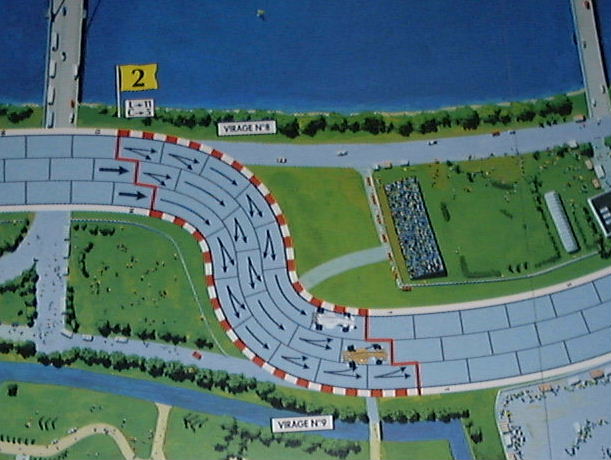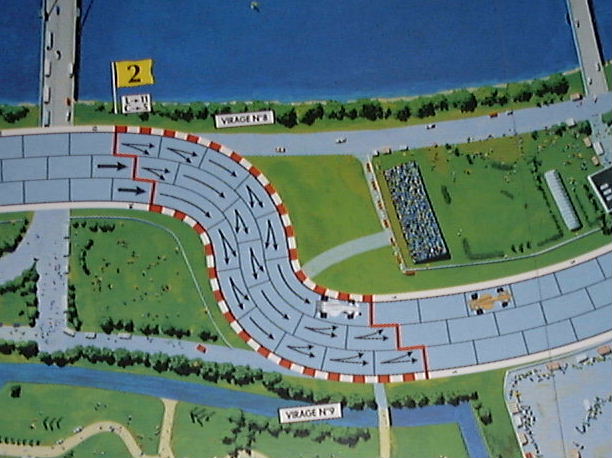Welcome
on the '98 Montreal Incident page, issued 1998.11.30, updated 1999.10.15
retour
aux stands
The
‘98 Montreal Incident
A
Textbook Example, or the Difference between Rules and Fair-Play
Described
herein is the famous “‘98 Montreal Incident” that happened on October 24th
during the first day of the ‘98 Masters. The exact racing conditions won’t
be described because they’re useless. The incident begins when player A,
after a violent discussion with the other players of the table, asks for
organization refereeing because player B is obviously trying to eliminate
him. Here’s how the situation looks like.
-
The 2 drivers
(we’ll call them White and Yellow for purpose of the illustrated example)
are coming into curve number 8 (2 stops, 11 squares max., 5 squares min.)
at full speed, White in 3rd gear and Yellow in 6th gear.
-
White, who
was playing first, stops at the very end of the curve on the inside lane.
-
Yellow,
playing immediately after White, stops at the very end of the curve in
the middle row.
-
Stage
1 : the 2 drivers have only made one stop and they have no square left
to go for their second stop. The other drivers play their turn.

-
Stage
2 : Yellow being in front of White by half a square, he plays first.
He spends 1 fuel, 1 brake and 1 engine to shift in 2nd gear. He rolls a
3 in 2nd gear and overshoots the curve on the left lane :

-
Stage
3 : Yellow spends 2 brakes to go back 2 squares. That way he only overshoots
by 1 square:

-
So, White
has no square left to go and is forced to pay 1 fuel, play in 1st gear
and hope to roll a one, the result of the die is 2. White has obviously
not enough brake points left and has to leave the race, crashing himself
on Yellow’s rear end, who automatically lose 1 body point.
-
It must
be said that Yellow had enough tyres left to overshoot by 2 squares instead
of 1. So his move is a deliberate try to eliminate White from the race.
I won’t
tell you about the discussions, arguings and remarks that occured during
at least half an hour. One of the game authors closed the subject by forbidding
Yellow’s move and by forcing him to overshoot at least by two squares,
this way letting White go on with the race. White then decided to leave
the race rather than follow the referee's decision.
Here’s
my personal analysis, do what you like with it :
-
Fair-play
is a proof of savoir-vivre and intelligence. It comes from common sens,
sens of honour and greatness of the soul. It has no strict or precise rules
and can’t be written down.
-
Yellow has,
technically speaking, the right to play the way he did (in Formula One,
nothing prevents a driver from braking of moving aside to eliminate an
opponent). If he remains impervious to fair-play, the rule can’t forbid
his move.
-
Yellow keeps
it up and thus shows proofs of a total lack of fair-play and exposes himselfs
to sanctions that can be decided by:
1) the
race referees (in the rule, all the players of a race are referees)
2) the
tournament referees
-
As his move
cannot be forbidden, the sanction must be proportionnal :
1) Immediate
expulsion from the race (after the victim has crashed) by vote, on the
basis of the majority of the players (if the concerned player has a team
partner, his partner can’t vote).
Or,
2) exclusion by the highests powers from the next Masters.
In conclusion
:
Well,
this incident is only an anecdote, but it points out the fair-play issue.
I must say once again that the ‘98 Masters were really successful. For
the most part, FD players are welcoming and are sympathetic people. I keep
on saying that no Driver’s Code of Honour should be written down because
drivers already know and apply it. This sport is a gentleman (and ladies!)
sport and will stay one, I truly believe it.
*

back
to top
